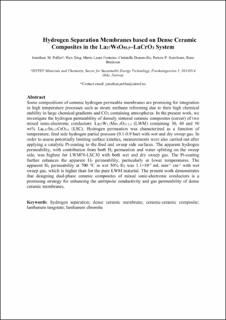| dc.contributor.author | Polfus, Jonathan M. | |
| dc.contributor.author | Xing, Wen | |
| dc.contributor.author | Fontaine, Marie-Laure | |
| dc.contributor.author | Denonville, Christelle | |
| dc.contributor.author | Henriksen, Partow Pakdel | |
| dc.contributor.author | Bredesen, Rune | |
| dc.date.accessioned | 2020-12-21T13:16:40Z | |
| dc.date.available | 2020-12-21T13:16:40Z | |
| dc.date.created | 2015-07-06T08:48:52Z | |
| dc.date.issued | 2015 | |
| dc.identifier.citation | Journal of Membrane Science. 2015, 479 39-45. | en_US |
| dc.identifier.issn | 0376-7388 | |
| dc.identifier.uri | https://hdl.handle.net/11250/2720619 | |
| dc.description.abstract | Some compositions of ceramic hydrogen permeable membranes are promising for integration in high temperature processes such as steam methane reforming due to their high chemical stability in large chemical gradients and CO2 containing atmospheres. In the present work, we investigate the hydrogen permeability of densely sintered ceramic composites (cercer) of two mixed ionic-electronic conductors: La27W3.5Mo1.5O55.5−δ (LWM) containing 30, 40 and 50 wt% La0.87Sr0.13CrO3−δ (LSC). Hydrogen permeation was characterized as a function of temperature, feed side hydrogen partial pressure (0.1–0.9 bar) with wet and dry sweep gas. In order to assess potentially limiting surface kinetics, measurements were also carried out after applying a catalytic Pt-coating to the feed and sweep side surfaces. The apparent hydrogen permeability, with contribution from both H2 permeation and water splitting on the sweep side, was highest for LWM70-LSC30 with both wet and dry sweep gas. The Pt-coating further enhances the apparent H2 permeability, particularly at lower temperatures. The apparent H2 permeability at 700 °C in wet 50% H2 was 1.1×10−3 mL min−1 cm−1 with wet sweep gas, which is higher than for the pure LWM material. The present work demonstrates that designing dual-phase ceramic composites of mixed ionic-electronic conductors is a promising strategy for enhancing the ambipolar conductivity and gas permeability of dense ceramic membranes. | en_US |
| dc.language.iso | eng | en_US |
| dc.publisher | Elsevier | en_US |
| dc.rights | Attribution-NonCommercial-NoDerivatives 4.0 Internasjonal | * |
| dc.rights.uri | http://creativecommons.org/licenses/by-nc-nd/4.0/deed.no | * |
| dc.subject | Lanthanum chromite | en_US |
| dc.subject | Lanthanum tungstate | en_US |
| dc.subject | Ceramic–ceramic composite | en_US |
| dc.subject | Dense ceramic membrane | en_US |
| dc.subject | Hydrogen separation | en_US |
| dc.title | Hydrogen separation membranes based on dense ceramic composites in the La27W5O55.5–LaCrO3 system | en_US |
| dc.type | Peer reviewed | en_US |
| dc.type | Journal article | en_US |
| dc.description.version | acceptedVersion | en_US |
| dc.rights.holder | This is the authors’ accepted and refereed manuscript to the article.This manuscript version is made available under the CC-BY-NC-ND 4.0 license DOI: https://doi.org/10.1016/j.memsci.2015.01.027 | en_US |
| dc.source.pagenumber | 39-45 | en_US |
| dc.source.volume | 479 | en_US |
| dc.source.journal | Journal of Membrane Science | en_US |
| dc.identifier.doi | 10.1016/j.memsci.2015.01.027 | |
| dc.identifier.cristin | 1252504 | |
| dc.relation.project | EU/280765 | en_US |
| dc.relation.project | Norges forskningsråd: 193816 | en_US |
| cristin.unitcode | 7401,80,3,2 | |
| cristin.unitcode | 7401,80,3,0 | |
| cristin.unitname | Tynnfilm og membranteknologi | |
| cristin.unitname | Bærekraftig energiteknologi | |
| cristin.ispublished | true | |
| cristin.fulltext | postprint | |
| cristin.qualitycode | 2 | |

